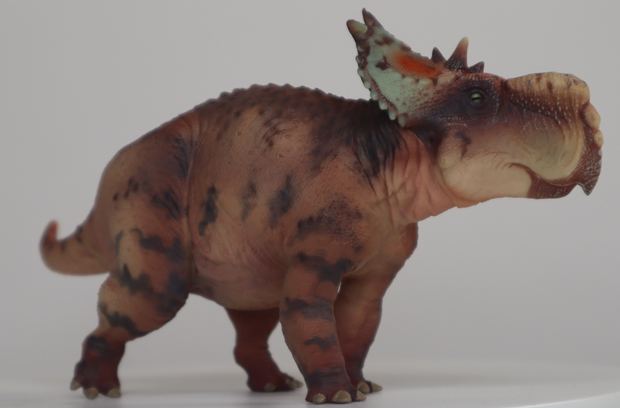Pachyrhinosaurus perotorum – New Research is Published
Puzzling Pachyrhinosaurs – The Remarkable Pachyrhinosaurus perotorum
Researchers from the Perot Museum of Nature and Science (Dallas, USA), in collaboration with the University of Toronto (Canada), have published an update on their research into one of the most remarkable Late Cretaceous dinosaurs known to science.
Pachyrhinosaurus perotorum
Back in 2011, Everything Dinosaur reported that field work in the high Arctic led by palaeontologists from the Perot Museum of Nature and Science had uncovered the fossilised remains of at least ten individual dinosaurs representing a new species of ceratopsian. This horned dinosaur, a pachyrhinosaur, was named Pachyrhinosaurus perotorum and it became the third species to be assigned to this centrosaurine genus. With numerous specimens to study, the palaeontologists could gain a fresh perspective on how horned dinosaurs changed as they grew up and develop a better understanding of the cranial ornamentation associated with the Ceratopsidae.
The Ontogeny of P. perotorum

Picture credit: Perot Museum of Nature and Science
Updating Their Findings About Pachyrhinosaurus
The authors of the original scientific paper describing P. perotorum, Anthony Fiorillo and Ronald Tykoski, have published a new report in conjunction with Kentaro Chiba of the Department of Ecology and Evolutionary Biology at the University of Toronto, updating their research and providing more information on how this species can be distinguished from the two other species of Pachyrhinosaurus.
The continued preparation of fossil specimens collected from the type locality, the Kikak-Tegoseak Quarry (Prince Creek Formation), has produced more skull elements to study. The researchers note that their original reconstruction of the type parietal bone was incorrect, the parietal along with the squamosal bone form the neck frill in horned dinosaurs. The parietal of P. perotorum is similar to the parietal bones of the other species – P. canadensis and P. lakustai.
It is postulated that Pachyrhinosaurus perotorum can be identified by an upturned tip of the rostrum, a dorsally shifted rostral bone lacking a sharply downturned, parrot-like beak and an enlarged median ridge at the posterior end of the nasal boss. Other differences in cranial morphology are also tentatively proposed in the new scientific paper, published in the Journal of Systematic Palaeontology.
A Speculative Illustration of the High Northern Latitude Ceratopsian Pachyrhinosaurus perotorum

Picture credit: Mark Witton
A Sister Taxon of Pachyrhinosaurus canadensis
A cladistic analysis undertaken by the team using this new dataset in conjunction with previous research confirms that the Pachyrhinosaurus genus is monophyletic (all descended from a common ancestor) and that Pachyrhinosaurus canadensis is the sister taxon to P. perotorum. In addition, this research supports the idea that parietal and squamosal frill ornamentations alone do not adequately address the variables in craniofacial morphology needed to distinguish between species of Pachyrhinosaurus.
The continuing research into horned dinosaurs that lived at high latitudes is helping palaeontologists to gain a better understanding of a unique ecosystem that existed towards the end of the dinosaur age. Pachyrhinosaurus perotorum is not only the youngest pachyrhinosaur species known, it is also the geologically youngest known centrosaurine. With three species assigned to the genus, Pachyrhinosaurus is the most speciose of all the Centrosaurinae genera.
A Model of a Pachyrhinosaurus

Picture credit: Everything Dinosaur
The picture (above) shows a Pachyrhinosaurus model in the Haolonggood range of figures.
To view this range: Haolonggood Prehistoric Animal Models.
Commenting About Pachyrhinosaurus perotorum
A spokesperson from Everything Dinosaur commented:
“Pachyrhinosaurus perotorum holds a special place in Ceratopsidae research. It lived at a higher latitude than any other horned dinosaur known to science and, as a consequence, had to endure some very tough and harsh climatic conditions. Whether this dinosaur was a seasonal migrant to the area in summer to take advantage of the 24-hours of daylight that permitted abundant plant growth, or whether this reptile was a permanent resident remains uncertain. However, the discovery of the fossilised remains of a juvenile at the Kikak-Tegoseak Quarry, suggests that this dinosaur could have been indigenous to northern Alaska during the Maastrichtian faunal stage.”
To read Everything Dinosaur’s original article from 2011 that announced the discovery of a third species of Pachyrhinosaurus: A New Species of Pachyrhinosaurus – P. perotorum.
The scientific paper: “New Data and Diagnosis for the Arctic Ceratopsid Dinosaur Pachyrhinosaurus perotorum” by Ronald S. Tykoski, Anthony R. Fiorillo and Kentara Chiba published in the Journal of Systematic Palaeontology.
Visit the Everything Dinosaur website: Everything Dinosaur.

